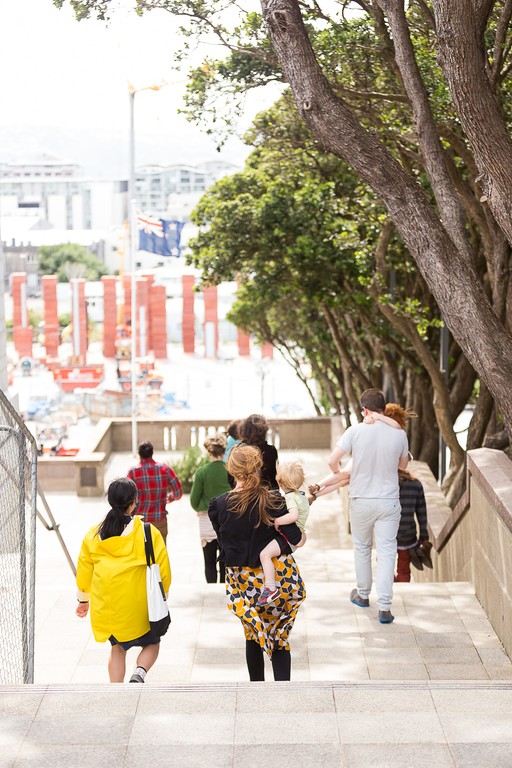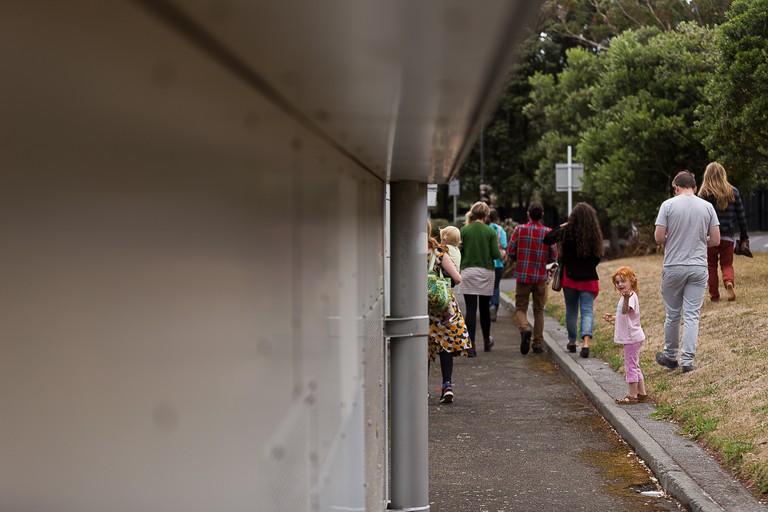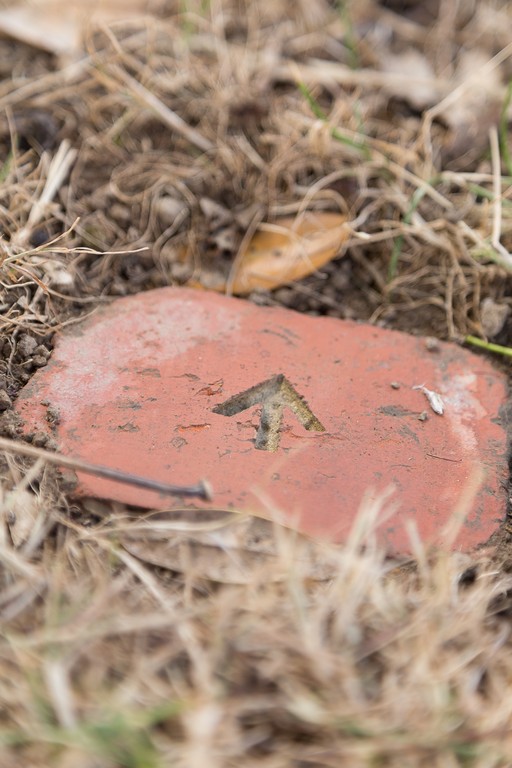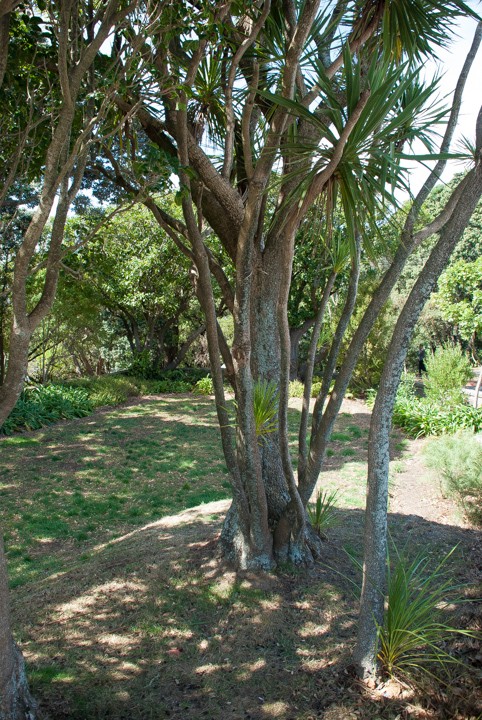Exhibition Essays
The levelling of Puke Ahu
March 2015
The Levelling of Puke Ahu

My first experience of the new Puke Ahu National War Memorial Park was through Enjoy’s recent offsite project The Levelling of Puke Ahu, curated by Emma Ng. Work on the Memorial was in full flight, with construction workers still laying down bricks and operating heavy machinery in order to meet the impending deadline of its official opening. The Puke Ahu National War Memorial Park was founded as the Government’s key project in acknowledging the Centenary of World War I, to remember the sacrifice of the 300,000 New Zealanders who fought, and the 30,000 who died. The memorial was to serve as a ‘centre piece’ for the 2015 Anzac Day commemorations, and create a public space around the National War Memorial–first built in 1932, which includes the Carillon, the Hall of Memories, and the Tomb of the Unknown Soldier. Although at the time incomplete, the vastness, and the dominance of this new Memorial and its purpose, was clearly evident. You simply can’t miss it.
Through The Levelling of Puke Ahu, four artists–Bronwyn Holloway- Smith, Izzy O’Neill & Aliyah Winter, and Angela Kilford–offered a critique and challenge of what has been physically represented, subverting ‘the narrative of mainstream understandings of New Zealand’s National Identity, so often associated with World War One and its aftermath,’1 as reiterated by the new Memorial Park.
Izzy O’Neill and Aliyah Winter’s performance on the first day was my introduction to this Enjoy offsite project. They marched down in unison past the old Dominion Museum building, holding a military stretcher between them and donning beige unitards that both distinguished them and brought about a distinct sameness. They placed the stretcher on the ground, Izzy was strapped into it, and Aliyah proceeded to drag her around the site of the War Memorial, onto Taranaki and Haining Streets, and back to the front of the Carillon. Although there was no dialogue between Izzy, Aliyah and the spectators during the performance, by taking us around the park, and the surrounding streets, they alluded to the different histories and narratives pertaining to the site, presenting a way to see what had been lost or forgotten in comparison to the scale of the new Memorial, and everything it stands to represent.
It was the same with Angela Kilford’s guided tour of the site. Beginning on the steps of the Dominion Museum, Kilford led the participants onto the grass area, under one of the trees, and conveyed the Māori story of creation, before taking the group around the site, discussing the existing memorials, proposed plans, the history of the area, the trees, and the construction and logistics behind the Park. Anyone could sign up for these walking tours, and within the simplicity and ease of the work, and the walk itself, Kilford allowed a dialogue to be built between the participants and the area’s narratives, through the of sharing these histories. Under a Pohutakawa tree, Kilford invited all those in the group to partake in a karakia that served as an acknowledgment of the site, the histories and one another, and marked the end of tour.
On this walk, she also highlighted Bronwyn Holloway-Smith’s small, quiet but potent interventions. An old brick, made from clay sourced on site, was embedded in the ground in front of the Museum with an arrow inscribed, pointing to a tree. Bronwyn’s work at Puke Ahu is placed in reference to a 1951 photograph of a vandalised cabbage tree at the Dominion Museum,2 and in conjunction with Thomasin Sleigh, Bronwyn contributed a poignant article on the mana and significance of trees to Enjoy’s Occasional Journal, The Dendromaniac, which also launched during this project.3


The area around Pukeahu/Mount Cook has played an important part in the history of New Zealand. Prior to the arrival of European Settlers, Pukeahu was used as a pa or fortified village by Te Ati Awa, a Māori tribe from Taranaki who settled in Te Whanganui a Tara/Wellington Harbour. When the settlers arrived in 1840 they saw Pukeahu as a great place for defence and set up their army, police barracks and prisons there, renaming Pukeahu as Mount Cook, after Captain James Cook. Prison labour was utilised to level the hill, to create flat ground for buildings, and to quarry clay for brickmaking. These bricks, marked with an arrow, were then used to construct the buildings and walls on Pukeahu, a history that Browyn Hollway-Smith’s works so aptly refers to. Almost ironically, between 1917 and 1919, conscientious objectors were also held as prisoners at Mount Cook. In 1931, the barracks were demolished to make way for the Dominion Museum. In 1932, the National War Memorial Carillon was opened and could be seen from any part of the city, and by ships entering the harbour. The transformation of landscapes, of instances; from conflicts, labour and violence, all this was defined by the hill Pukeahu.
The Pukeahu National War Memorial Park’s objectives have been previously described as:
the national place for New Zealanders to remember and reflect on this country’s experience of war, military conflict and peacekeeping, and how that experience shapes our ideals and sense of national identity. 4
This claim that New Zealand’s involvement in the war shaped a national identity fails to acknowledge many important parts of New Zealand’s history: the Musket Wars, the New Zealand Wars between 1845–1872, the 1863 New Zealand Settlements Act, and the events of Parihaka for instance. In relation to this particular site of Pukeahu, where the War Memorial commands the most engagement, the reality of its founding are ignored.
Furthermore, the commemorations around the WWI Centenary have been sensationalised, with Tony Abbott taking part in the dedication ceremony for the Australian Memorial at Puke Ahu, through to flamboyant street parades featuring vintage WWI vehicles and poppy confetti, the opening of Peter Jackson’s Great War Exhibition in the old Dominion Museum building, Sir Richard Taylor’s Gallipoli: The Scale of Our War at Te Papa and a sharp increase in commercialised memorabilia. These events and ceremonies have further contributed to a narrative that overlooks the true cost of this war, and the wider social history and implications of New Zealand’s involvement. They stand to further promote the notion that it was ‘a fight for freedom’ that frames our collective national identity, and a view that doesn’t allow for the discussion and questioning of what it was all really for and about.

Through projects like The Levelling of Puke Ahu, artists are given the opportunity to open up new lines of dialogue and examine what looking back on what our nation’s history can tell us about our current positions on our past and future conflicts. On the final leg of Kilford’s walk, the group was asked to pause outside one of the windows of the Museum Building, where Holloway-Smith’s small, patchwork flag hung in the centre, which read ‘For the battles at home, may we remember them, so we do not repeat them’, a sentiment that summarises in part the counter arguments to the spectacle of war commemoration.
because artists often gravitate to what is missing, many have committed themselves to creating events that connect people and ideas in the public sphere because they discern what is missing now in public discourse. 5
Through Puke Ahu’s many iterations, as a prison, military barracks, national museum and art gallery, and a university campus, have seen it slowly levelled and worn away as the land and its history have been rewritten. By taking this project offsite and beyond the walls of the gallery, the artists were allowed, through their respective contributions to this project, to ask important questions around what gets remembered and what doesn’t. It extended the conversations beyond the gallery’s physical building and opened them up to the public, highlighting the importance
of intimate, relational connections, between art, artist and spectator, and how that can take on a new line of interrogation that cuts across the mainstream narrative.

I sat down with Izzy O’Neill and Aliyah Winter, and interviewed them about their involvement in the project, and their response to the site. Here is what they had to say...
Elisabeth: What do you consider to be the philosophies in each of your personal practices?
Aliyah: This is really hard because I don’t feel as though I have settled on one thing as my practice yet, but I am interested in suppressed narratives, the way we think about history, and how history is remembered. Especially on what terms we remember people; how their personal experience of the world doesn’t translate through history. Also, challenging the ways in which history is written, because it is always written from a particular perspective and I guess we have this idea that history is a neat sequence of events but really it is about upholding power.
How do you feel this work relates to your recent photographic exploration, Memorial? (Memorial/Whakararatia was recently exhibited in Disrupting the Narrative, at Thistle Hall)6
A: Yes, when I was researching for the Memorial work, I spent heaps of time walking around the site [Puke Ahu]. Walking was a really important act, and I was really thinking about the traces of a presence – the prisoners had been there, they had made these bricks and there were all these hints as to this landscape having changed so much by the labour of people, and the people were still there in some form or another. I was also tapping into that in the performance.
And Izzy?
Izzy: In my work I am also interested in the construction of identities and narratives of people. I also draw a lot of inspiration from feminist theory, feminist art theory and I focus a lot on women’s identities. I look at how seemingly limited they are and why this is the case, why women are seen to be not be so complex.
Would you be able to describe, in your own words, what took place?
I: The performance started at our house in Mount Cook, with us walking in silence carrying a military stretcher, in our specific attire through Tasman Street, through Massey [University], down through the Great War Memorial, and down the right hand side car park.
We walked to the new concrete area, and aligned ourselves with the Carillon. It was there that we placed the stretcher down. I guess, for the audience, our descending down from the driveway, maybe even us putting down the military stretcher, or Aliyah strapping myself into it, would have been the start of the performance. But for us, it really was when we left our home together and walked in silence.
From there, Aliyah dragged me on the stretcher around the site, down Taranaki Street, round the perimeter of the memorial and back to the front of the Carillon, where she lay the stretcher down, and untied me. Together, we left, almost the same way we arrived, back to our house.

Was the work then, a response to the new War Memorial?
I: It is not specifically the War Memorial that ourselves or other people have a problem with. It is a collection of things, and again, it is a whole lot more complex than it seems.
There is a collection of hidden or oppressed histories that have not come to the surface, because this ANZAC memorial has been given so much more value in terms of scale, and in a monetary sense, which says that these are the ‘important’ histories. For myself with my practice, there is a consideration of intersectional feminism and how white, cis male narratives often dominate.
A: Feeding off what Izzy said, another aspect of my work and research that I don’t really talk about as much is Feminism and Queer theory, especially when thinking about the gaze, the ‘other’ and our ideas of people being ‘othered’.
Are you both primarily performance based artists?
A: Performative/performance based.
I: I would say performative because there is something in the action of being performative, of not necessarily being a performer.
It’s weird what I do. I do it because I am an artist, but I hate that I have to do it. I almost feel, especially with this performance, that Aliyah and I are like ants in comparison to the power that we are trying to challenge. Ants compared to the numbers of New Zealanders that are commemorating ANZAC.
I was wondering, as the work is performative and you are physically, and mentally struggling in order to make it happen, does that feel more honest to you, rather than it being purely for theatre or a spectacle?
A: It was a response to the theatre that was being built. The Memorial is a theatre; in the same way people talk about the theatre of war being the battlefield. It was a response to this theatre and how this theatre was carrying out its own narrative, and I think that is definitely the relationship I see between how we think about things and how they manifest. You can reverse engineer that from the site, to say that this is how people think about history, this is how people think about the war. It reveals so much more.
To me, the work operated almost as participatory, because right from the get go you had people who had come to see a performance, but followed you both around the site for the whole duration of the work. The second performance of this work felt almost as if it was a procession, perhaps because it was a lot slower than the first, and people were committing a lot more of their time to engaging with the work. For example when, you, Aliyah paused and put the stretcher down in order to catch your breath and, I guess prepare yourself for the next leg, everyone stopped with you, and waited until you were ready to set off again. You had everyone else operating on the same or a similar level then, to you two.
I: That is really interesting to hear. One of the reasons Aliyah and I did this work together was because we really wanted white New Zealand to become conscious of it’s complicit nature and involvement in the oppression of Māori people, or suppression of other histories, narratives and stories within a New Zealand context.
Aliyah and I, in our discussions, were well aware that we are white. Our bodies represent whiteness through space, through being able to freely move through space. Even though Aliyah isn’t typically the most dominant male, rather a gender non-conforming white female, she was still putting herself as the ‘poster child’; you take responsibility for your involvement in this subjugation.
We see it historically. We see it in our education systems. We see it when more monetary value is given to this memorial of ANZAC when, right on the same site there is Māori History to do with Parihaka prisoners not acknowledged. We see oppression in all sectors of society, even in terms of the health care system with who is represented or who isn’t.
There were a few really concerning moments, for instance when you were being yelled at by some of the construction workers for the tracks you were leaving on site, as a result of the wooden wedges. Obviously, these workers felt very protective of the site they were constructing, how did you interpret that idea, or their response?
A: They had a lot of pride in their labour, which I would not want to dismiss for a second, because I think that this is completely valid, just as the pride we felt over what we do. So it was not something I was ever particularly angry about but I did notice that both times I was yelled at, it was by a white man. It was in a particular way that was very...
I: threatening. It was very targeted towards Aliyah. There were two of us involved in the performance and there was a procession of at least 15 other people, but Aliyah was targeted. I couldn’t see what was going on because of where I was physically situated within the performance, and I feel Aliyah was targeted because Aliyah was very feminine, she had shaved legs that day, I was the opposite, I had very hairy legs and unshaved armpits. We were both very gender non-conforming in that binary sense.
Aliyah was also the one dragging the other, deeming her perhaps as the instigator?
A: I definitely think that had something to do with it as well.
Recently I was at a protest, at the front holding a banner. Valerie Morse, who was leading the protest, was up the front and someone was coming over to us. I assumed they would talk to Valerie because she was the one leading the protest, she is a well-known person and they went immediately for the oldest man who was behind her, holding the other side of the banner.
This illustrates so perfectly that people don’t talk to women because they automatically don’t assume them to be leaders in any sense. So of course I was the one who was going to be yelled at.
I: Aliyah and I spoke heaps about our roles within this performance. From us personally defining our own gender binaries, to myself deliberatley being in such a submissive position to Aliyah, with her being the ‘active’ participant. That has been really interesting, having a leader or the perceived leader of the collaboration, when it has been mutually collaborative. Emma had asked if I wanted to be a part of this project as she had come across my work Recommended Reading, which was a censored letter between staff and their employer who was a strip club owner in Wellington. 7 After talking to her about what I was thinking of doing, I asked Aliyah if she would help me out, as he is so invested in the history of Parihaka, and she had done some great work on it.
Aliyah, did you find that the physical strain impacted you emotionally? We could all see quite plainly that you were in a lot of physical anguish.
A: There was one point in the second performance where I broke down but I don’t know if the audience noticed. I was crying and trying very hard to fight it because we were walking past the Mount Cook Police Barracks.
What really got to me was thinking about the prison industrial complex on that site in relation to the Parihaka prisoners and anyone else whose labour was exploited. The overall experience was sort of beyond being able to talk about it, that sort of got me thinking about what happens when people go through hard labour, what physically happens to your body.
It isn’t ‘oh you’re just very tired’ you literally can’t speak, you can’t think, you can’t function as a human being so I think that personally that experience was like re-performing that trauma and feeling. It was really overwhelming and I found it so hard to even think about it afterwards, the next day or even the next week. It was still far removed, and there was this absolute lack of my ability to put it into words.
And for you Izzy? I assume it was just as physical, despite you not having to move. You were very rigid for the duration of the performance, and we witnessed you grabbing at the bar above your head, almost to hold yourself in place.
I: Physically I was not as challenged in comparison to other performances I have done, but it was challenging to keep my body upright for the twenty or so minutes of the performance.
I was emotionally exhausted for a month leading up, and after and the two weeks between each performance because I felt this work was so precious, and to Aliyah as well. We are very very aware of race—especially because we are both feminists—and this intersection with race impacts how you navigate your way through life and life in New Zealand.
We didn’t want the work to be interpreted in the wrong way. So for me that was mentally exhausting, because you don’t want to offend anyone and that’s why we also focused on our own whiteness—because the collective socialisation of white people is something we should not be proud of in New Zealand. And there is no shame in admitting that, but it is shameful to not admit or acknowledge this.
Though we are part of the problem, we are also part of the solution as well. No one wants to admit that to themselves or recognise how, historically, they are involved in racial oppression. So it’s really important alongside that critique to provide some sort of solution or show that there are people who are against these structural systems that delegate power and to bring awareness to it.
Otherwise, if you just present the problem, people can feel so hopeless and overwhelmed, disappointed and resistant. In the work we really wanted to show that is going to be laborious, hard, long, it’s going to be emotionally tiring.
I think what is so incredible about the work is how it does operate as a ‘blank canvas’ and can pertain to have these multiple stories being represented.
A: Joe Kum Yung’s murder on Haining Street is another one of these hidden histories. I actually found out about that murder from a book in Unity [Books] called How to be Dead in a Year of Snakes by Chris Tse. All the poetry in the book was centred around this and I knew it was in Wellington, but I did not realise it was on Haining Street until I started researching it.
We were directly trying to draw people to these other histories. There is a memorial there, it is on a really small Wellington City drain cover, but that’s it. How do we remember this horrible hate crime, versus this war that we fought in overseas? It’s a ridiculous contrast between these two things and originally the entire war memorial was supposed to go down the length of Tory Street, which means it would have covered the place where Joe was murdered, and where Haining Street was which was part of a huge Chinese community. It’s not remembered in the same way.
I: Our work definitely had a specific focus, but it wasn’t ever singular. It all stems from that idea of what we give value to and how we allocate value to that in our society, is it through scale, or money? What do we not learn about, what have we not heard? It goes far beyond remembering it through a memorial.

-
1.
Thomasin Sleigh and Bronwyn Holloway-Smith, “In search of unknown vandals” Enjoy Occasional Journal: The Dendromaniac, 3 (2015). http://journal.enjoy.org.nz/ the-dendromaniac
-
2.
Alexander Turnbull Library, “Vandalised cabbage tree at the Dominion Museum, [ca 25 January 1951], Reference Number: 114/254/07-G”, http://mp.natlib.govt.nz/ detail/?id=58294&l=mi
-
3.
Enjoy Occasional Journal: The Dendromaniac, 3 (2015), http://journal.enjoy.org.nz/
-
4.
Ministry for Culture and Heritage, “Pukeahu National War Memorial Park”, http://www.mch.govt.nz/pukeahu/park
-
5.
Carol Becker, “Microutopias: Public Practice in the Public Sphere” in Living As Form: Socially Engaged Art from 1991-2011, ed. Nato Thompson (Cambridge: The MIT Press, 2012), 64-71.
-
6.
“Remember The Peacemakers”, Thistle Hall Community Venue, http://www.thistlehall.org.nz/projects/ww100.html
-
7.
Izzy O’Neil, “Recommended Reading”, http://www.izzyoneill.com/sex-work.html
